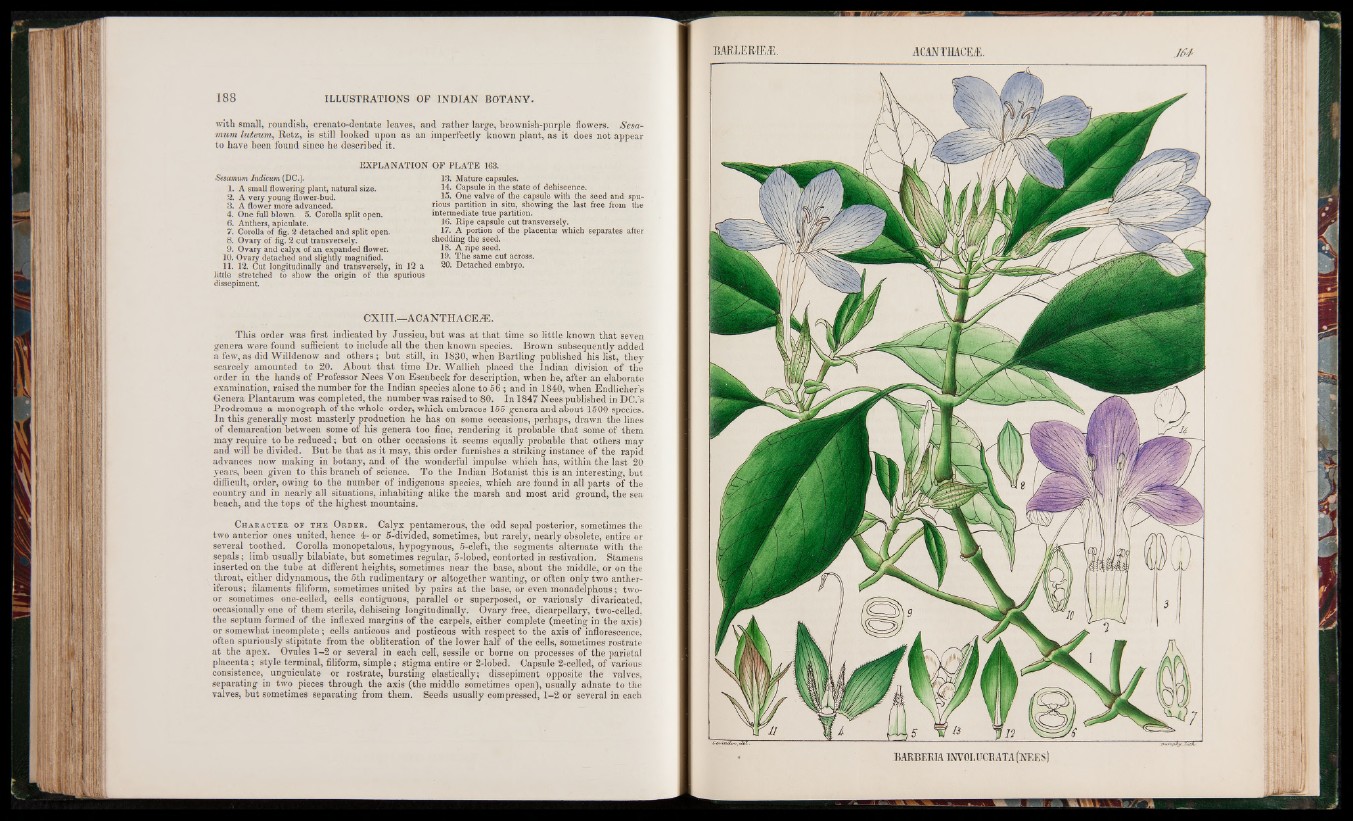
with small, roundish, crenato-dentate leaves, and rather large, brownish-purple flowers. Sesa-
mum luteum, Retz, is still looked upon as an imperfectly known plant, as it does not appear
to have been found since he described it.
EXPLANATION OF PLATE 163.
Sesamum Indicum (DC.).
1. A small flowering plant, natural size.
2. A very young flower-bud.
3. A flower more advanced.
4. One full blown. 5. Corolla split open.
6. Anthers, apiculate.
7. Corolla of fig. 2 detached and split open.
8. Ovary of fig. 2 cut transversely.
9. Ovary and calyx of an expanded flower.
10. Ovary detached and slightly magnified.
11. 12. Cut longitudinally and transversely, in 12 a
little stretched to show the origin of the spurious
dissepiment.
13. Mature capsules.
14. Capsule in the state of dehiscence.
15. One valve of the capsule with the seed and spurious
partition in situ, showing the last free from the
intermediate true partition.
16. Ripe capsule cut transversely.
17. A portion of the placentas which separates after
shedding the seed.
18. A ripe seed.
19. The same cut across.
20. Detached embryo.
CXIII.—ACANTHACEiE.
This order was first indicated by Jussieu, but was at that time so little known that seven
genera were found sufficient to include all the then known species. Brown subsequently added
a few, as did Willdenow and others; but still, in 1830, when Bartling published his list, they
scarcely amounted to 20. About that time Dr. Wallich placed the Indian division of the
order in the hands of Professor Nees Yon Esenbeck for description, when he, after an elaborate
examination, raised the number for the Indian species alone to 56 ; and in 1840, when Endlicher’s
Genera Plantarum was completed, the number was raised to 80. In 1847 Nees published in DC.’s
Prodromus a monograph of the whole order, which embraces 155 genera and about 1500 species.
In this generally most masterly production he has on some occasions, perhaps, drawn the lines
of demarcation between some of his genera too fine, rendering it probable that some of them
may require to be reduced; but on other occasions it seems equally probable that others may
and will be divided. But be that as it may, this order furnishes a striking instance of the rapid
advances now making in botany, and of the wonderful impulse which has, within the last 20
years, been given to this branch of science. To the Indian Botanist this is an interesting, but
difficult, order, owing to the number of indigenous species, which are found in all parts of the
country and in nearly all situations, inhabiting alike the marsh and most arid ground, the sea
beach, and the tops of the highest mountains.
Character of the Order. Calyx pentamerous, the odd sepal posterior, sometimes the
two anterior ones united, hence 4- or 5-divided, sometimes, but rarely, nearly obsolete, entire or
several toothed. Corolla monopetalous, hypogynous, 5-cleft, the segments alternate with the
sepals; limb usually bilabiate, but sometimes regular, 5-lobed, contorted in aestivation. Stamens
inserted on the tube at different heights, sometimes near the base, about the middle, or on the
throat, either didynamous, the 5th rudimentary or altogether wanting, or often only two anther-
iferous; filaments filiform, sometimes united by pairs at the base, or even monadelphous; two-
or sometimes one-celled, cells contiguous, parallel or superposed, or variously divaricated,
occasionally one of them sterile, dehiscing longitudinally. Ovary free, dicarpellary, two-celljed,
the septum formed of the inflexed margins of the carpels, either complete (meeting in the axis)
or somewhat incomplete; cells anticous and posticous with respect to the axis of inflorescence,
often spuriously stipitate from the obliteration of the lower half of the cells, sometimes rostrate
at the apex. Ovules 1—2 or several in each cell, sessile or borne on processes of the parietal
placenta; style terminal, filiform, simple; stigma entire or 2-lobed. Capsule 2-celled, of various
consistence, unguiculate or rostrate, bursting elastically; dissepiment opposite the valves,
separating in two pieces through the axis (the middle sometimes open), usually adnate to the
valves, but sometimes separating from them. Seeds usually compressed, 1-2 or several in each
EARLERffiÆ ACANTHACEÆ.
BARBERIA ÜNV0LUCRATA (]SEES)